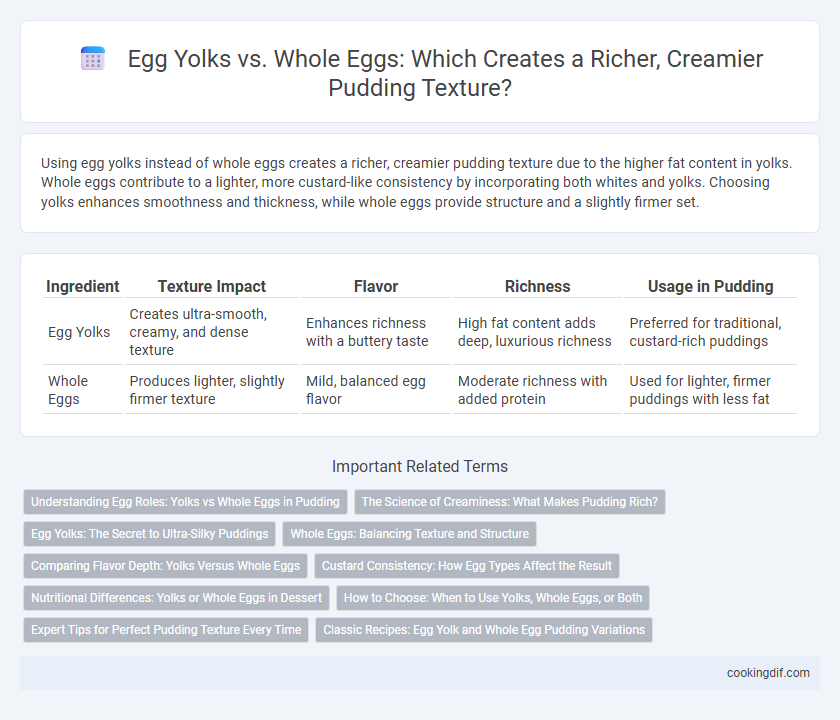Using egg yolks instead of whole eggs creates a richer, creamier pudding texture due to the higher fat content in yolks. Whole eggs contribute to a lighter, more custard-like consistency by incorporating both whites and yolks. Choosing yolks enhances smoothness and thickness, while whole eggs provide structure and a slightly firmer set.
Table of Comparison
| Ingredient | Texture Impact | Flavor | Richness | Usage in Pudding |
|---|---|---|---|---|
| Egg Yolks | Creates ultra-smooth, creamy, and dense texture | Enhances richness with a buttery taste | High fat content adds deep, luxurious richness | Preferred for traditional, custard-rich puddings |
| Whole Eggs | Produces lighter, slightly firmer texture | Mild, balanced egg flavor | Moderate richness with added protein | Used for lighter, firmer puddings with less fat |
Understanding Egg Roles: Yolks vs Whole Eggs in Pudding
Egg yolks provide a rich, creamy texture in pudding due to their high fat content and emulsifying properties that enhance smoothness and thickness. Whole eggs contribute structure and stability but can lead to a firmer, less velvety consistency compared to yolk-only recipes. Balancing yolks and whole eggs allows precise control over the pudding's texture, richness, and density.
The Science of Creaminess: What Makes Pudding Rich?
Egg yolks play a crucial role in achieving a rich pudding texture due to their high fat and lecithin content, which acts as natural emulsifiers to create a smooth, creamy consistency. Whole eggs contribute structure and volume but can result in a firmer texture because of their higher protein content, which coagulates during cooking. The balance of yolks to whole eggs influences the pudding's silkiness and mouthfeel, with yolks enhancing richness and whole eggs providing stability.
Egg Yolks: The Secret to Ultra-Silky Puddings
Egg yolks contain high levels of fat and lecithin, which act as emulsifiers to create a velvety, ultra-silky pudding texture by binding fat and water molecules effectively. Using egg yolks alone enhances richness and smoothness, resulting in a creamier mouthfeel compared to whole eggs, which can yield a firmer, less delicate custard. Concentrated yolks increase the pudding's golden color and luxurious consistency, making them the secret ingredient for gourmet-quality desserts.
Whole Eggs: Balancing Texture and Structure
Whole eggs provide a balanced blend of rich texture and stable structure in pudding, combining the fat content of yolks with the protein from whites to create a creamy yet firm consistency. The proteins in egg whites contribute to setting the pudding, preventing it from becoming overly dense or greasy, while the yolks add smoothness and depth of flavor. This synergy results in a pudding that holds its shape well while maintaining a luscious, velvety mouthfeel ideal for both custard and mousse varieties.
Comparing Flavor Depth: Yolks Versus Whole Eggs
Egg yolks contribute a richer, creamier texture and more intense flavor depth to pudding due to their higher fat content and emulsifying properties, enhancing the dessert's luscious mouthfeel. Whole eggs add structure and firmness but can dilute the richness, resulting in a lighter texture with less pronounced flavor complexity. Using yolks alone allows for a more decadent taste experience, while whole eggs create a balanced pudding with moderate richness and stability.
Custard Consistency: How Egg Types Affect the Result
Egg yolks contribute a richer, creamier custard consistency due to their higher fat content and emulsifying properties, resulting in a thicker, silkier pudding texture. Whole eggs provide structure and firmness but can yield a slightly lighter, less velvety custard when compared to yolk-only recipes. Balancing the ratio of yolks to whites allows precise control over the pudding's richness and firmness, optimizing the custard's mouthfeel and stability.
Nutritional Differences: Yolks or Whole Eggs in Dessert
Egg yolks are rich in fats and emulsifiers, providing a creamy, rich texture essential for decadent pudding, while whole eggs contain additional proteins that contribute to structure and firmness. Nutritionally, yolks offer higher levels of vitamins A, D, E, and essential fatty acids, whereas whole eggs provide a balanced source of protein and essential nutrients like choline. Choosing yolks enhances richness and creaminess but increases fat and calorie content, whereas whole eggs yield a slightly lighter texture with more protein and fewer fats.
How to Choose: When to Use Yolks, Whole Eggs, or Both
Egg yolks create a rich, creamy pudding texture due to their high fat content and emulsifying properties, ideal for custard-based recipes requiring silkiness. Whole eggs contribute structure and firmness, making them suitable for puddings that need a slightly denser consistency or baking applications. Using both yolks and whole eggs balances richness and stability, perfect for achieving a smooth yet set pudding texture.
Expert Tips for Perfect Pudding Texture Every Time
Using egg yolks instead of whole eggs creates a richer, creamier pudding due to the higher fat content and emulsifiers in yolks that enhance smoothness and thickness. Expert chefs recommend tempering the yolks gradually with warm milk to prevent curdling and achieve a silky texture. For consistently perfect pudding, maintain a gentle heat while stirring constantly and avoid boiling, which can cause separation and graininess.
Classic Recipes: Egg Yolk and Whole Egg Pudding Variations
Classic pudding recipes often distinguish between using egg yolks and whole eggs to achieve a rich, creamy texture. Egg yolks contribute a velvety smoothness and intense richness due to their high fat content, ideal for custard-style puddings like creme brulee. Whole eggs provide more structure and a firmer set, commonly found in traditional bread puddings and baked custards, balancing richness and stability.
Egg yolks vs whole eggs for rich pudding texture Infographic

 cookingdif.com
cookingdif.com